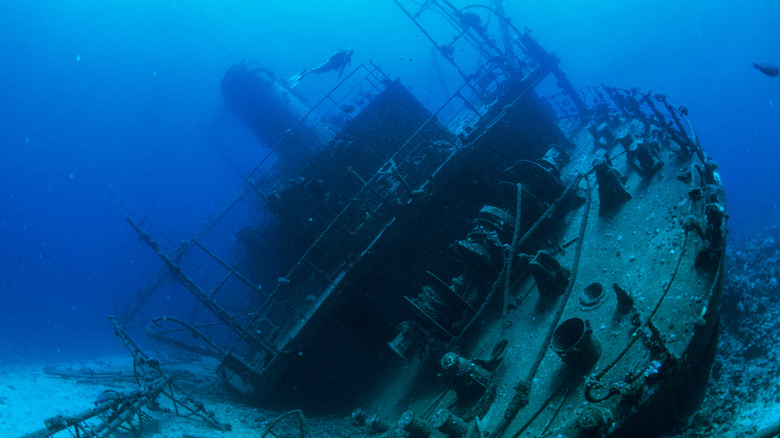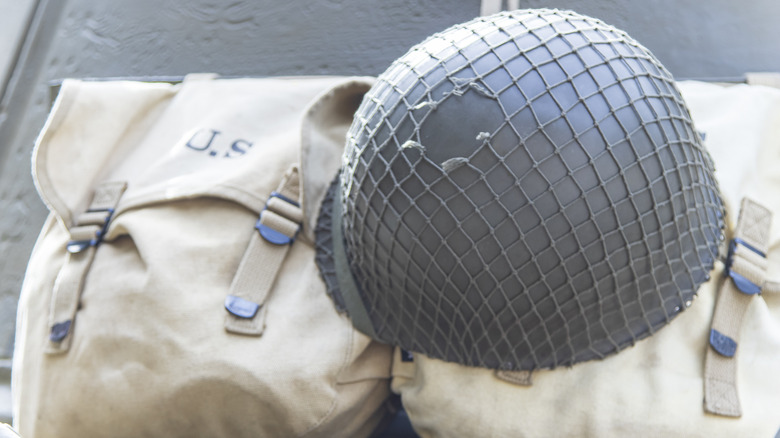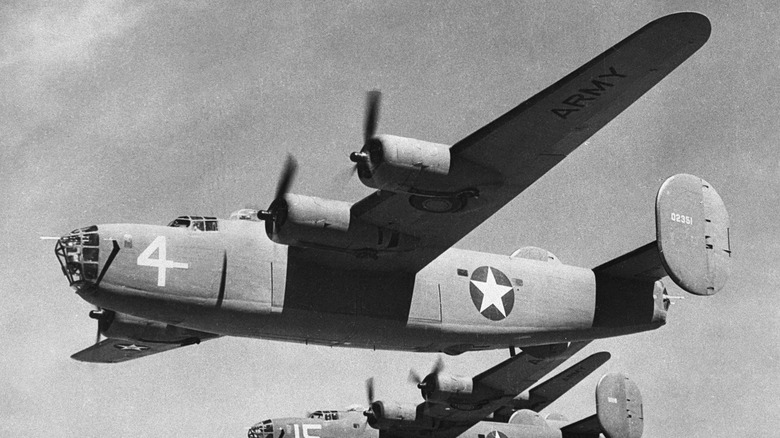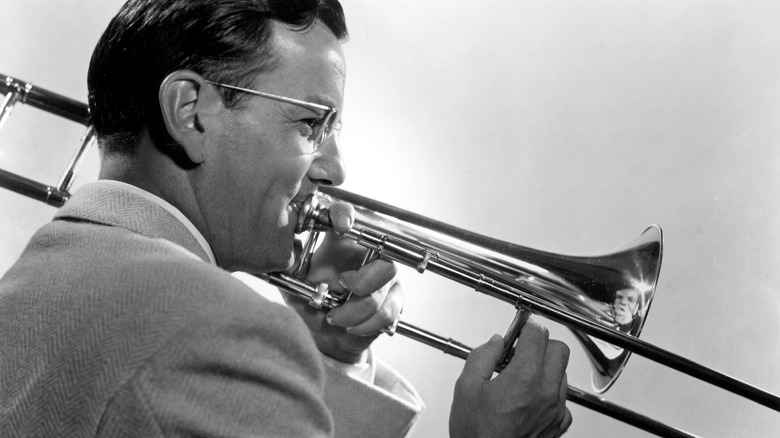World War II Mysteries That Were Solved Years Later
It's interesting that a major world event like World War II still contains so many unknowns. For instance: Did Nazi Germany really build a secret Antarctic base plus something-something under-the-snow pyramids and alien collaborators? Okay, no, that didn't happen — no need to spread ludicrous rumors. Did Hitler actually not shoot himself and instead escape to Argentina and die there in 1962? No again. Like we said: No spreading rumors.
When we talk about World War II mysteries, we mean things that seem far more mundane but are far more relevant because they involve real lives and often tragic, unresolved deaths. Oftentimes, like in the case of the HMS Trooper submarine or the Lady Be Good B-24D bomber a craft goes missing along with its crew. Sometimes a case is as simple as a missing person who stands out from all the other millions of missing people throughout World War II because the circumstances of his disappearance are so odd, like Private Andrew Ladner. Sometimes a case gets solved via something as simple as letters, diaries, or other physical artifacts boxed away somewhere in storage, such as those revealed through "Antiques Roadshow."
Many of such cases, as the reader can see, involve a missing something-or-other being found and identified. Sometimes it takes years, sometimes it takes decades. But in all cases, these kinds of World War II mysteries only get resolved through the diligent work of folks determined to figure out exactly what happened.
The recovery of the HMS Trooper
We can start with the most recent World War II mystery to be solved, one that reflects many other lost vehicles and/or people mysteries: the discovery of the HMS Trooper. A British submarine due to arrive at Beirut, Lebanon, On October 17, 1943, the Trooper didn't show up as scheduled. While no big, historically notable battles were happening at the time, Britain did set out to reclaim the Dodecanese islands from the Axis powers in September that year, one month before the Trooper vanished. The Dodecanes islands are located in the Aegean Sea east of mainland Greece, a point integral to the Trooper's fate.
Very recently on October 17, 2024 — 81 years to the day after the Trooper was supposed to arrive at its destination – Greek diver Κostas Thoctarides discovered the Trooper by sonar near the island of Donoussa in the Dodecanes. As Smithsonian Magazine says, he used remote-controlled vehicles to investigate further and found the sub resting 830 feet below the surface. Thoctarides announced in a Facebook post that the Trooper is the eighth submarine that he and his underwater salvage company Planet Blue have found. There were 15 other previous attempts to locate the Trooper, per Dive Magazine.
Unsurprisingly, it looks like the Trooper suffered a violent fate. The vessel is shattered into three pieces, implying that it struck one of the 287 mines that Germany laid in the region during World War II. All 64 men on board died.
The remains of Private Andrew Ladner
About 60 million total people died during World War II, including three times more civilians (45 million) than soldiers (15 million). The numbers of the missing are no less ridiculous, with Russia suffering the most missing soldiers at over 4.5 million. The United States still has almost 81,000 military personnel missing from the war, with new remains being discovered and identified right up to the present. In fact, you can browse the Defense POW/MIA Accounting Agency's full list of missing personnel. Army servicemen with last names starting with "A" account for 823 of the lost. Such specificity indicates precisely how serious the business is of bringing all lost soldiers home.
So then, it shouldn't be surprising that the recovery of one single individual makes news, in this case Private Andrew Ladner. Ladner stands out from his peers because he didn't go missing and then die, he died and then went missing. As his official Defense POW/MIA Accounting Agency profile says, he died during the Battle of Buna-Gona in New Guinea on November 30, 1942, and was buried north of New Guinea's village of Soputa. Then, folks couldn't locate his grave.
It took until 2016 for a set of remains at the Manila American Cemetery and Memorial to be identified as Ladner's. As Riemann Family Funeral Homes writes, Ladner's remains landed in New Orleans on April 1, 2022, and were buried at his family plot at Wolf River Cemetery in Mississippi with full military honors.
The lost crew of Lady be Good
The Air Force Historical Support Division says that the United States alone utilized over 100 different types of aircraft during the war. The quantity of crafts ballooned from 2,500 to 300,000 by the end of the war. Each craft had a different function, such as the "B" series of bombers like the B-17, B-24, B-25, B-26, and B-29. One of those B-24Ds comes equipped with a tale of heroism unknown until its recovery: the "Lady Be Good."
The "Lady Be Good" was one of 25 B-24Ds that took off on April 4, 1943, for Soluch airstrip near Benghazi, Libya. The planes left in staggered groups, with their objective being to conduct a bombing raid against the Italian harbor at Naples. "The Lady Be Good" was one of the last to leave, and headed along the same fateful path as the other B-24Ds over the Libyan Desert, which is part of the vast Sahara Desert. But unlike many of the other planes, the "Lady Be Good" and it's crew of nine didn't turn around upon encountering sandstorms and powerful winds. Plus, it was dark.
The "Lady Be Good" overshot the Soluch airstrip, ran out of fuel, and crash-landed in the desert. According to the National Museum of the U.S. Air Force, eight of the crew's remains were eventually found. Several set out across the sands. Five made it 78 miles on foot, and one 109 miles. Another man's remains were found near the plane. This story took form over 15 years after the crash in 1958, when the wreck of "Lady Be Good" was spotted 400 miles south of Soluch.
A nephew found via Antiques Roadshow
Our next World War II mystery comes equipped with an unexpected team-up: the U.K. version of the long-running antiques-appraisal show, "Antiques Roadshow." Interestingly enough, "Antiques Roadshow" has cleared up a number of World War II-related mysteries. In 2019 they revealed 50 documents related to the fates of civilian evacuees, as Express recounts. In 2024 a full-on D-Day special episode unveiled objects like letters written to relatives of still-living family, per the Daily Mail.
In 2018 "Antiques Roadshow" turned full "Unsolved Mysteries" by roping its viewership into unraveling the story behind a briefcase of possessions. Judging by the telegram in the briefcase dated November 9, 1941, the briefcase belonged to World War II prisoner-of-war Hubert Henderson. As Express explains, the briefcase's caretaker Suzanne (no last name given) appeared on the show representing her uncle, who'd bought a box containing the briefcase 10 years prior at auction for £25. The briefcase was essentially a collection of mementos related to the deceased Henderson, a pilot with the British Royal Air Force, and Suzanne wanted to track down to whomever it rightfully belonged.
Suzanne teamed up with historian Tony Hoskins and revealed their findings on "Antiques Roadshow" in 2019. They discovered that a picture in the briefcase wasn't of Henderson, but his friend Alastair Sandy Gunn. Eventually, the team found Henderson's nephew, John. He was happy to receive the briefcase and had apparently known about his uncle's and Sandy's friendship. He'd even named his son Alistair, after Gunn.
Clues into Glenn Miller's missing plane
We're going to end on a case that's technically not completely solved, but closer to a resolution. Specifically, we're talking about the disappearance of musician-turned-serviceman Glenn Miller of Glenn Miller's Orchestra fame. And if you had no idea that Miller wasn't just the band leader and trombonist for classics like "In the Mood" and "Chattanooga Choo Choo," but left civilian fame to join the Army? You're not alone.
As misfortune would have it, Miller disappeared en route from Bedfordshire, England to Versailles, France to play for U.S. troops stationed there. Neither he, his UC-64A Norseman aircraft, his crew, or any other trace has ever been found — suggesting his flight crashed in the English Channel. Some theories propose that his plane was accidentally bombed by the British Royal Air Force. But as War History Online explains, evidence dating to 2018 suggests that this wasn't the case, which brings Miller's case one step closer to solving.
Per War History Online, Miller's family recruited historian Dennis Spragg to investigate Miller's death. He eventually got a hold of diaries penned by 17-year-old Richard Anderton in Reading, England dating to 1944 that saw Miller's plane pass by overhead. Anderton's brother, Sylvan, had brought them to "Antiques Roadshow" and later donated them to the Glenn Miller Birthplace Museum in Iowa, which Spragg works with. If the Norseman was in this area then it couldn't have been bombed by the RAF, which supports the U.S. Army's previous investigation into Miller's disappearance. Spragg believes that the carburetor in Miller's plane froze midflight and the plane vanished beneath the waves of the English Channel.





